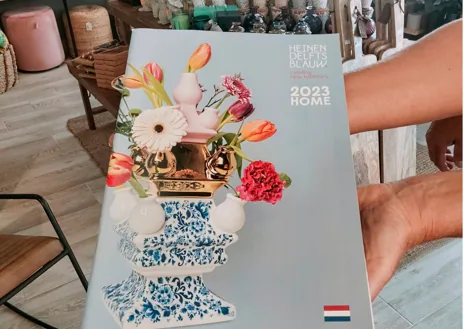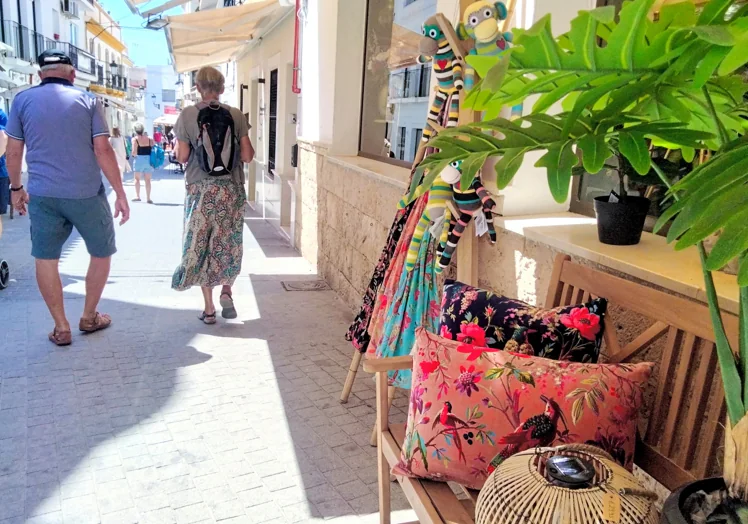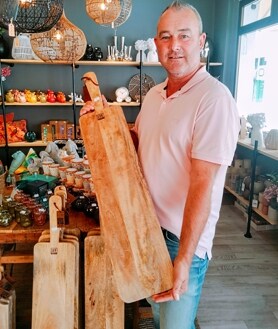Nerja goes orange as more Dutch businesses open
Last year Dutch couple Twan and José returned to the Costa del Sol, bringing with them the essence of design from the Netherlands to the coast; this week their displays show the colour of Koningsdag (King's Day) celebrated on 27 April
Alekk M. Saanders
Nerja
Miércoles, 26 de abril 2023, 10:32
It's that time of the year again when the people of the Netherlands celebrate their 'Orange Day', one of the holidays the country is best known for. Koningsdag (King's Day) does not just involve covering everything in orange in honour of the royal family, the House of Orange-Nassau, or eating, drinking and merrymaking.
In Holland 27 April is that one day of the year that the public can set up shop on the streets without a trading licence but in spaces on pavements marked with chalk or tape.
27 April is that one day per year in Holland that the public can set up shop on the streets without a trading licence
Since last spring, the Costa del Sol has a space where Dutch accessories and furniture are sold all year round. As well as new pieces, some of the items are old, though creatively upcycled or repurposed.
The shop, owned by Dutch couple, Twan van Enckevort, 50, and José van Bennekom, 57, is always marked by something orange and more features in that traditional colour are to be added this Thursday - at the same time Queen's and King's Day, as José and Twan call the holiday.
The couple were quick to explain this confusion. Ten years ago, King Willem-Alexander's mother Beatrix abdicated, thereby interrupting the successive line of female monarchs since the national holiday began in the late 1880s. It means that Koninginnedag (Queen's Day) was switched to today's Koningsdag (King's Day).
Double emigration
From a soft sofa in their cosy shop, Twan and José told SUR in English the story of how their journey to this comfort in Nerja was quite long and took two attempts.



“We emigrated to Spain in 2005 and started our life in Andalucía, quite far from the coast. Mollina is the premier wine and olive oil producing town in Malaga province. However, it was chosen because of the Spanish courses we had attended in Holland.
"There we made friends with a woman who had bought a house in the town close to Antequera. It was easier for us to move somewhere where we had friends or acquaintances. Later, we settled in Colmenar in the Axarquía, closer to José's new job in real estate. When, in 2009, I found a job in La Carihuela in Torremolinos (which has a significant Dutch community), we decided to move to Alhaurin de la Torre," Twan explained.
"It was easier for us to move somewhere where we had friends or acquaintances"
Twan and José
Nerja appeared in the path of Twan and José thanks to the hotel business. The couple rented a small hotel in Nerja and ran the first B&B in the town. It was a success though due to a misunderstanding with the local owner and a family matter, Twan and José moved back to the Netherlands in 2014.
"Back in Holland we realised that Nerja was our true home and decided to emigrate a second time"
José van Bennekom
“In the city of Venray I was involved in the design business. So I have learned more about new influences in the design world. I managed to establish contacts with Dutch designers and brands. At the beginning of last year we felt that we really missed the Costa del Sol. Being in Holland we realised that Nerja was our true home. We were getting itchy feet again so much that we made the decision to emigrate a second time,” José said.
Dutch design on the Costa
The Dutch couple opened a home decoration shop at the end of one of the streets in Nerja most popular with tourists and diners. The name for the boutique was chosen with a special meaning. 'LEF' means 'courage' in Dutch. Twan and José think it is the right word to describe their decision to emigrate, twice.
“Suddenly we realised that the Costa del Sol has stores presenting Swedish, Danish, Irish and German, among others, designs. But few know about Dutch design, despite its contribution into the design world. Dutch Design Week in Eindhoven is the largest design event in Northern Europe and presents work and concepts from more than 2,600 designers. So, 'why not to open a home furnishing store in our new home, Nerja?' we asked ourselves,” Twan and José said.
Asked, answered and done. The LEF deco collection represents a diverse range of Dutch designers and brands - furniture, homeware and accessories. Even if not to buy, many local and foreign residents as well as tourists drop in this colourful shop just to plunge into the pleasant atmosphere with the smell of wood, and even learn more about the creative Holland.
Apparently, the real success of Dutch design dates back to 1653 when Royal Delft was founded and started creating high-quality blue and white ceramics
Apparently, the real success of Dutch design dates back to 1653 when Royal Delft was founded and started creating high-quality blue and white ceramics. In the 17th and 18th centuries the manufacture of Delftware was a major industry, exporting its production all over Europe. Some ceramics inspired by Delft blue can be found in the shop, including tiles, typical of Andalusian interiors as well.



The modern character of Dutch design is permeated with simplicity, creativity and a sense of humour that help in creating the spirit of contemporary design in any living space. In the Nerja shop, the clocks are simple, the lamps are creative and the vases are really funny. Some of the displayed cutting boards are very popular with local restaurateurs who adjust Dutch design for 'the king of local specialities' - tapas.
“Incidentally, there is a bar opposite us owned by a Dutch person. Moreover, a supermarket selling Dutch food is a stone's throw from us. It looks as though we have already formed here a sort of 'orange triangle'.
"It means that Nerja is getting a little bit more Dutch, or rather 'orange' in the place known for its 'Blue Summer',” Twan and José stressed, in reference to the eighties TV series Verano Azul that made the town famous.
-kCzD-RDDPPoQIslpxMrbmS33CEsK-1200x840@DiarioSur.jpg)